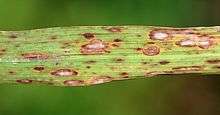Cochliobolus miyabeanus
| Cochliobolus miyabeanus | |
|---|---|
 | |
| Symptoms of Cochliobolus miyabeanus on rice | |
| Scientific classification | |
| Domain: | Eukaryota |
| Class: | Dothideomycetes |
| Order: | Pleosporales |
| Family: | Pleosporaceae |
| Genus: | Cochliobolus |
| Species: | C. miyabeanus |
| Binomial name | |
| Cochliobolus miyabeanus | |
Cochliobolus miyabeanus (formerly known as helminthosporium oryzae) is a fungus that causes brown spot disease in rice. This disease was the causal agent of the Bengal famine of 1943.
It was used by the USA as a biological weapon in Japan during World War II.[1]
See also
References
- ↑ Suffert, Frédéric; Émilie Latxague; Ivan Sache (11 March 2009). "Plant pathogens as agroterrorist weapons: assessment of the threat for European agriculture and forestry". Food Security. Springer Netherlands. 1 (2): 221–232. doi:10.1007/s12571-009-0014-2. Retrieved 14 May 2009.
Sources
- World Food Crisis: Meeting the demands of a growing population by Jeff Batten, APS/CPS Annual Meeting, Monday, August 9, 1999
This article is issued from Wikipedia - version of the 6/29/2016. The text is available under the Creative Commons Attribution/Share Alike but additional terms may apply for the media files.